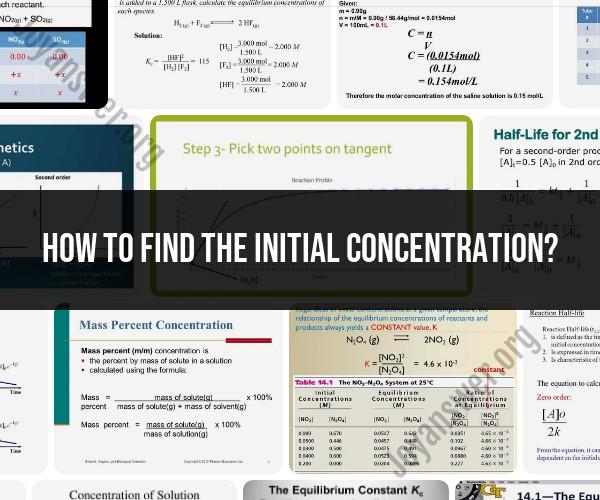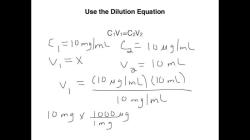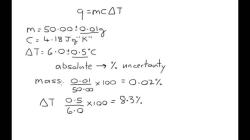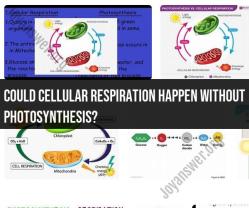How to find the initial concentration?
To find the initial concentration of a substance in a chemical reaction, you can use various methods and calculations depending on the information available and the specific circumstances of the reaction. Here are some common methods and calculations to determine the initial concentration:
Direct Measurement: In some cases, the initial concentration of a substance can be directly measured or known because you have prepared the solution or substance. For example, if you mix 50 mL of a 0.2 M (molar) solution of sodium chloride (NaCl) with 50 mL of water, the initial concentration of NaCl is 0.2 M.
Stoichiometry: If you know the stoichiometry of the reaction and the initial concentration of one of the reactants, you can calculate the initial concentration of the other reactants or products. This method is commonly used in balanced chemical equations.
For example, consider the reaction:2A + 3B → 4C
If you know the initial concentration of B is 0.1 M, and you know that A and B react in a 2:3 ratio, you can calculate the initial concentration of A:(Initial concentration of A) = (Initial concentration of B) × (Ratio of A to B)(Initial concentration of A) = 0.1 M × (2/3) = 0.067 M
Dilution: In some cases, you may need to dilute a solution to find the initial concentration. The dilution equation is used when you know the initial concentration of a more concentrated solution and the volume of solvent (usually water) added to it.
The dilution equation is:(C1V1) = (C2V2)
Where:
- C1 = Initial concentration of the concentrated solution
- V1 = Volume of the concentrated solution
- C2 = Final desired concentration (initial concentration)
- V2 = Final volume of the diluted solution (V1 + V solvent)
Rearrange the equation to solve for C2 (the initial concentration):C2 = (C1V1) / V2
Spectrophotometry: In chemical analysis, spectrophotometry is used to measure the concentration of a substance in a solution by measuring the absorbance or transmission of light through the solution. By comparing the measured absorbance to a calibration curve of known concentrations, you can determine the initial concentration.
Titration: In titration, a solution of known concentration (titrant) is used to react with a solution of unknown concentration (analyte) until the reaction is complete. The volume and concentration of the titrant used can be used to calculate the initial concentration of the analyte.
These methods are just a few examples of how you can determine the initial concentration of a substance in a chemical reaction. The choice of method depends on the specific details of the reaction and the available information.
How to Calculate Initial Concentration in Chemistry
The initial concentration of a solution is the concentration of the solution before any reaction has taken place. It is typically measured in moles per liter (M).
To calculate the initial concentration of a solution, you need to know the following:
- The mass of the solute (the substance that is dissolved in the solution)
- The volume of the solution
Once you have this information, you can use the following formula to calculate the initial concentration:
Initial concentration = mass of solute / volume of solution
For example, if you have 10 grams of sodium chloride (NaCl) dissolved in 1 liter of water, the initial concentration of the solution would be:
Initial concentration = 10 grams NaCl / 1 liter solution = 10 M NaCl
Methods for Determining the Starting Amount of a Substance in a Reaction
The starting amount of a substance in a reaction can be determined in a number of ways, including:
- Weighing the substance: If the substance is a solid, it can be weighed using a balance. If the substance is a liquid or a gas, it can be weighed using a volumetric flask.
- Measuring the volume of a solution of the substance: If the substance is dissolved in a solution, the volume of the solution can be measured using a graduated cylinder or a volumetric flask. The concentration of the solution can then be used to calculate the amount of the substance present.
- Using a titration: A titration is a laboratory technique that can be used to determine the amount of a substance in a solution by reacting it with another substance of known concentration.
Practical Examples of Finding Initial Concentration in Chemical Reactions
Here are a few practical examples of finding initial concentration in chemical reactions:
Example 1: You are preparing a solution of hydrochloric acid (HCl) to be used in a titration experiment. You need to prepare a 1 M HCl solution. To do this, you will need to dissolve 36.5 grams of HCl in 1 liter of water.
Example 2: You are performing a chemical reaction that requires 0.5 moles of sodium hydroxide (NaOH). You have a 1 M NaOH solution. To obtain 0.5 moles of NaOH, you will need to use 500 mL of the NaOH solution.
Example 3: You are performing a titration experiment to determine the concentration of a solution of sulfuric acid (H2SO4). You titrate a 25.0 mL sample of the H2SO4 solution with a 1.0 M NaOH solution. You use 40.0 mL of the NaOH solution to reach the equivalence point. The initial concentration of the H2SO4 solution can be calculated using the following formula:
Initial concentration of H2SO4 = (volume of NaOH solution used) * (concentration of NaOH solution) / (volume of H2SO4 solution used)
Initial concentration of H2SO4 = (40.0 mL) * (1.0 M) / (25.0 mL) = 1.6 M
Therefore, the initial concentration of the H2SO4 solution is 1.6 M.












